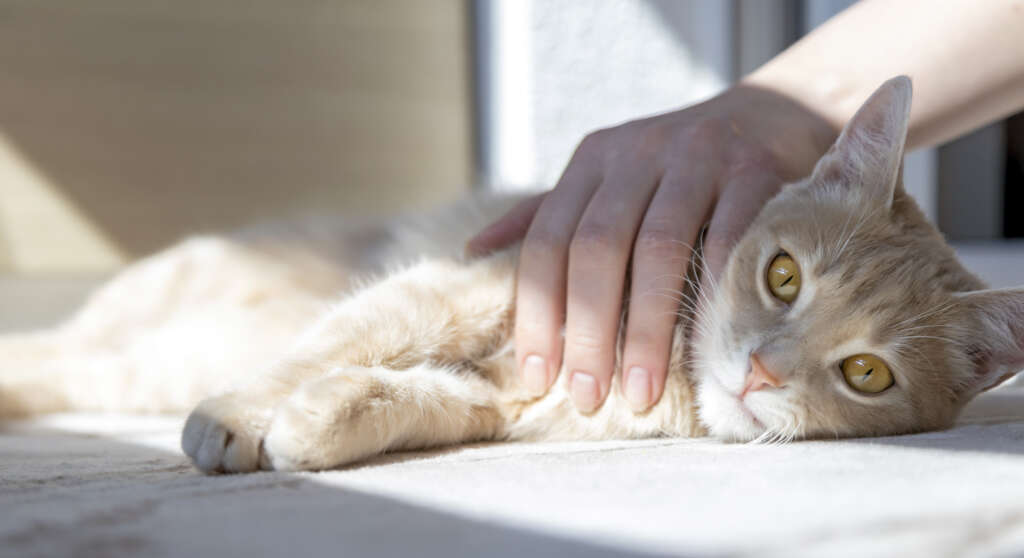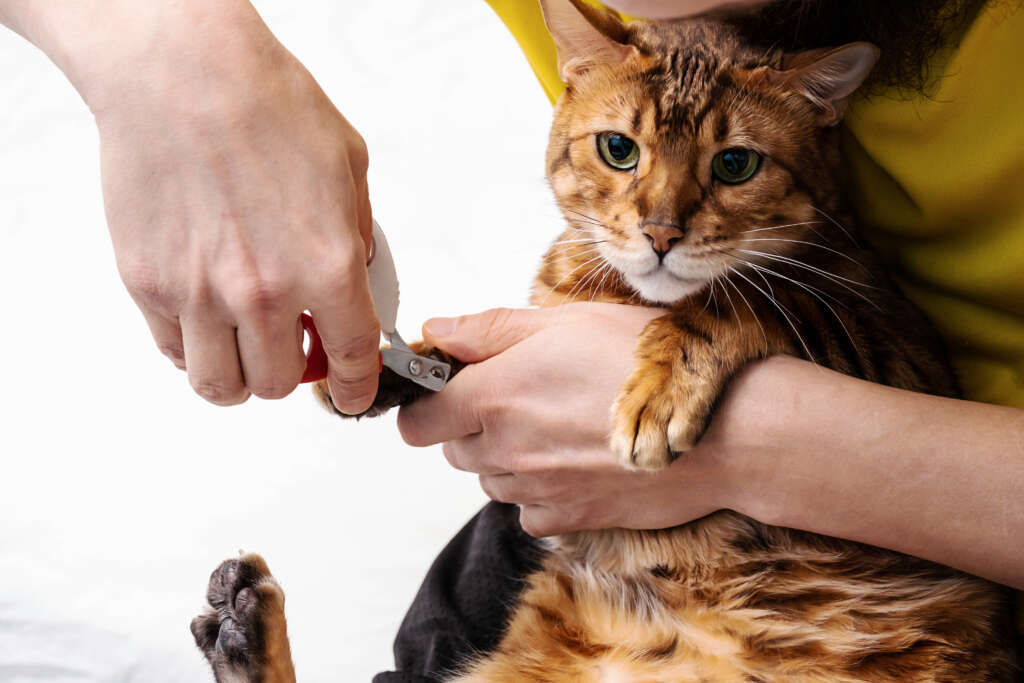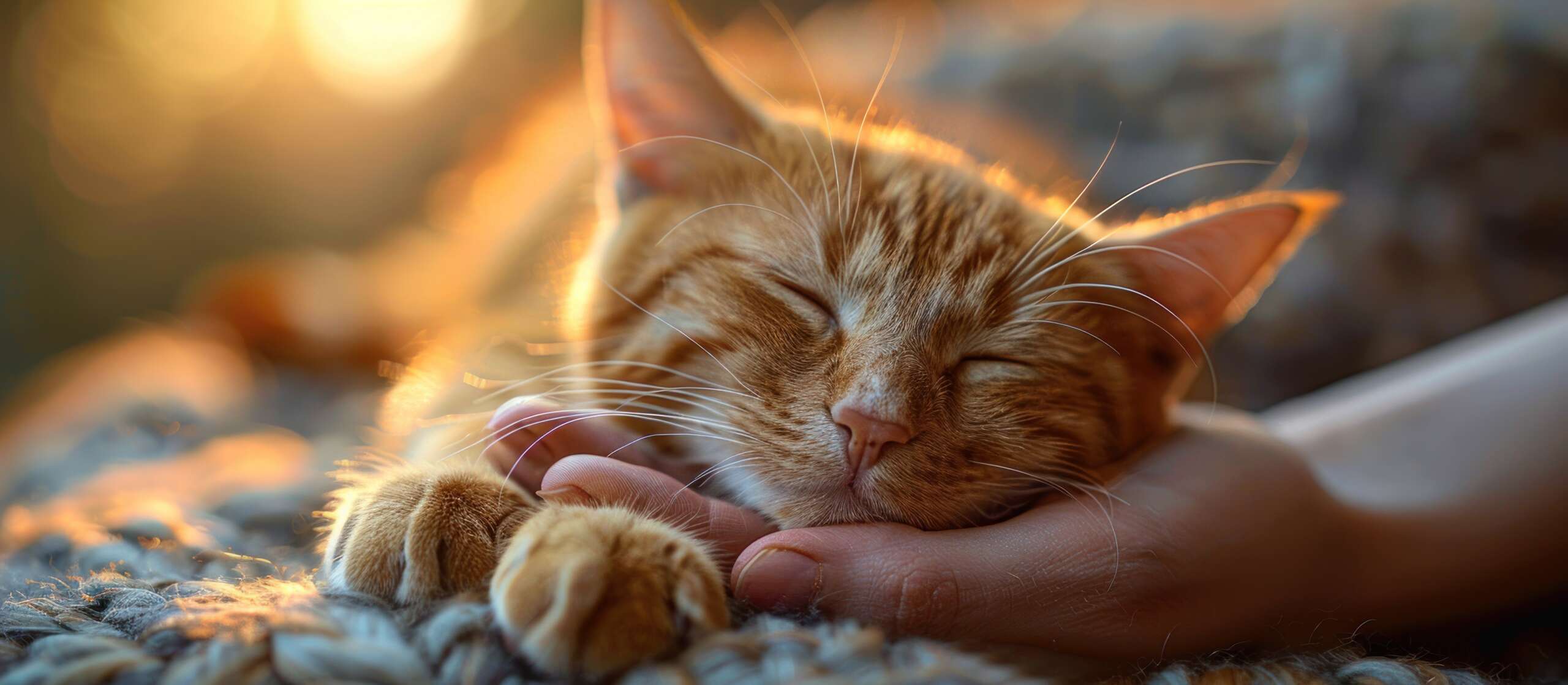Share This Article
Did you know the sound of a clicking cat tiptoeing on a hardwood floor means it’s time for a trim? Many cat owners wonder how often to safely trim cat’s nails to keep their pets healthy and furniture safe. Whether you’re new to pet care or a long-time cat lover, learning cat nail trimming is key for your pet’s health.
Regular claw care is crucial to protect your home and your cat’s health. Kittens need weekly trims, while older cats might only need them monthly. Outdoor cats often keep their nails trimmed naturally, but they might need less frequent trims.
Not trimming your cat’s nails can cause paw pad injuries and affect their walking. Long nails can also damage your furniture. But, how do you avoid cutting the quick and make cat nail trimming a positive experience?
Using the right tools like scissors, guillotine, or nail grinders makes trimming stress-free. Cutting at a 45-degree angle is best for your cat’s comfort. Learning to trim a cat’s nail without cutting quick and knowing what to do if you do will keep your pet’s paws healthy. Check out our cat nail trimming tips to improve your pet’s life.
Are you ready to learn more? Our guide is packed with expert advice, starting with the importance of regular claw care.
Understanding the Importance of Regular Claw Care
Keeping up with cat nail care is key for your cat’s health. For indoor cats, trimming nails every two to four weeks stops overgrowth. This is important for their comfort and health. Cats with long nails might get annoyed, leading to scratching or biting.
Cat nail health is crucial to avoid problems like ingrown claws. If a cat’s nails curl and dig into their paw pads, it hurts. This can lead to infections or joint issues from walking differently. Regular safe nail trimming for cats helps prevent these problems, keeping your pet happy and safe.
What your cat does affects how often they need their nails trimmed. Outdoor cats wear down their claws and might need less trimming. Indoor cats, especially older or less active ones, might need more regular trims. Polydactyl cats with extra toes also need special care to trim all nails safely.

Starting a cat nail care routine early makes trimming less stressful for both you and your cat. Use sharp cat nail clippers and know where the quick is to trim safely. If you cut the quick, have styptic powder ready to stop the bleeding.
Regular claw care prevents health problems and keeps your cat comfortable and active. Doing safe nail trimming for cats regularly boosts their health and strengthens your bond through gentle handling.
Safely Trim Cat’s Nails: Preparing for the Task
Getting ready to trim your cat’s nails is more than just picking up clippers. Creating a calm setting and using the right feline nail-trimming techniques make the process safe and easy for your cat. It’s key to know the tools and steps for a good experience for both you and your cat.
Start by choosing the right tools. Use cat nail scissors or clippers made for cats to avoid splitting or damaging their nails. Introduce these tools slowly to your cat to lessen their anxiety about the sound and look. Keep styptic powder on hand for any cuts. Learning to trim your cat’s nails takes time, often weeks or months.
Before trimming, make sure to cut only the nail tips to avoid the quick. This can hurt and bleed if cut. Giving a treat after each paw can help your cat see nail trimming as positive. Watch for signs of stress like pulled-back ears or a twitching tail, which means it’s time for a break.
Getting your cat used to having you handle their paws makes nail trims easier. Use gentle pressure and reward them with treats and love for being calm. This helps with nail trims and keeps your cat healthy by preventing injuries and infections from long nails.
If your cat is still scared after trying to get used to it, see a vet or a professional groomer skilled in safe nail trimming for cats. This ensures your pet’s safety and keeps their nails healthy, especially if they don’t like regular grooming at home.
Step-by-Step Guide to Clipping Your Cat’s Claws
Learning how to trim cat nails starts with the right tools. Use scissors or guillotine clippers made for cats, not human ones. They might split the nails and hurt your pet. Make sure your cat is calm and comfy before you begin. A calm setting makes the trimming easier for both of you.

Start by gently holding your cat’s paw and pushing the claw out a bit. Be careful to see the quick, which is the pink part near the claw base. It has nerves and blood vessels. Trim only the clear part of the nail at a 45-degree angle. Cutting the quick can hurt your cat and cause bleeding.
Have styptic powder ready if you cut the quick by mistake. It stops the bleeding and helps your cat feel better.
Experts say to check and trim your cat’s nails every 2 to 4 weeks. Older cats might need it done weekly. Watch for signs that your cat’s claws are too long. These include catching on things, tapping sounds on hard floors, or seeing the claws when they’re sitting still.
After trimming, give your cat treats to make the experience good. If your cat doesn’t like nail trimming, do it over several days. This lowers stress and helps your cat get used to cat nail trimming tips. Also, give them a scratching post to keep them from scratching your furniture.
In conclusion, doing nail trims right and often is key to your cat’s health and comfort. Use these tips to make nail care better for your cat.
Avoiding Common Mistakes in Feline Nail Trimming
For stress-free cat nail care, it’s key to know and avoid common mistakes. Don’t start trimming without the right tools like clippers and styptic powder. Make sure your trimming area is quiet and comfy to help your cat feel at ease.
Don’t cut your cat’s nails too short to avoid pain and bleeding. Make small cuts instead. Using dull clippers can split the nail and cause infection. Always use sharp clippers made for cats for clean cuts.
Never rush through the trimming process. Get your cat used to paw handling before trimming. If your cat gets upset, stop and try again when they’re calm. Treats during and after can make the experience positive.

Make nail care a positive experience for your cat. If it’s hard, get help from a vet or groomer. With gentle handling and rewards, your cat might even enjoy nail trimming.
Ensuring a Stress-Free Experience for Your Feline Friend
Keeping your cat’s nails trimmed is key to their health and happiness. Starting nail trimming early, like when they’re kittens, makes it easier as they get older. This helps both you and your cat have a better experience.
Pick a quiet time, like after a meal, to trim your cat’s nails. Make sure the area is calm and free from distractions. Use gentle handling and give treats and affection to make the experience positive.
It’s crucial to use the right tools and techniques for trimming cat nails. Cat claw clippers are made just for their claws. Only clip the nail tip to avoid the quick, which is very sensitive. If you cut the quick, use styptic powder to stop the bleeding.
If you’re not sure about trimming your cat’s nails, consider getting help from a pro. Groomers and vets can show you how to do it right during health checks. Regular visits to a trusted professional can make nail care stress-free for your cat, keeping them happy and healthy.
Maintaining a Routine for Cat Nail Health
Keeping our feline friends healthy means having a steady cat nail care routine. Experts say cats should get their claws trimmed every week and a half to two weeks. This keeps their claws at a good length, stopping them from getting too long or causing harm.
For the best cat nail health, short, regular trimming sessions work best. The ASPCA warns against declawing because it’s banned in many places and is harmful. It can cause lasting pain for cats. Regular trimming helps keep cats healthy and behaving naturally. Indoor cats need their nails trimmed every ten days to two weeks. Senior cats or those moving inside might need more frequent care.
Starting this routine can be easy and fun for your cat. Using treats and positive feedback helps them feel good about it. If your cat doesn’t like it, consider a professional groomer or a vet’s advice. Most pet owners find nail trimming a simple part of their cat’s care. Always give your cat a treat after to make the experience positive.


